|
|
Aston Martin V8 Vantage
|
 |
|
|
Debut: 2005
Maker: Aston Martin
Predecessor:
No
|
|
|
|
Published
on 5
Oct 2005
|
All rights reserved.
|
|
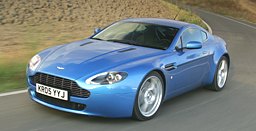 In
my mind the name "Aston V8 Vantage" always refer to an old fashion, big
V8 British grand tourer. It sat on the top of Aston's lineup and was
hand-produced at a rate of a few dozens a year, if lucky. Now Aston use
the same name for a modern, high-tech and nimble sports car. On the
contrary to its predecessor, it becomes the entry-level Aston and will
be produced at 3,000 cars a year. It will be Aston Martin's 911. In
my mind the name "Aston V8 Vantage" always refer to an old fashion, big
V8 British grand tourer. It sat on the top of Aston's lineup and was
hand-produced at a rate of a few dozens a year, if lucky. Now Aston use
the same name for a modern, high-tech and nimble sports car. On the
contrary to its predecessor, it becomes the entry-level Aston and will
be produced at 3,000 cars a year. It will be Aston Martin's 911.
All the good changes happened recently at Aston should be down to
Ulrich Bez, the Aston boss who had been the father of Porsche 993
during his long service at the German sports car maker. Bez knows so
well what made Porsche so successful - quality, image and character,
apart from performance and driving fun. I guess he should also know his
flyweight company cannot match Porsche in engineering expertise. No
wonder he doesn't like to call the V8 Vantage a 911 fighter.
Unfortunately, almost all motoring writers do this, and many compare
both cars side by side to find out which one is better. And you can
guess the result. Yes, Aston may be David, but Porsche is far smarter
than Goliath.
Sorry for telling you the result so early, but I just want to say we
had better to understand V8 Vantage. At £80,000, it is in a
segment where subjective feeling like image and character dominate the
buying habit. If you think a 911 Carrera S is better simply because it
goes faster, handles better and £15,000 cheaper, then you would
be wrong. Does the 911 possess a look so beautiful as the Aston? does
its cabin feel as bespoke as the Aston? can it match the rarity of the
Aston? when you spend so much money, do you want to be treated as a
royal customer, or just one of the 100,000 customers every year
purchasing a Porsche vehicle?
 The V8
Vantage's beautiful shape is again penned by Henrik Fisker. Compare
with the 2+2 DB9, the 2-seater V8 Vantage looks sportier. It is a true
sports car shape - unlike 911 which is still a coupe shape - with
flared fenders, very short tail and a sleek rising wedge shape. Aston
signature grille dominates the nose, as is the side ventilation behind
the front wheels. The V8
Vantage's beautiful shape is again penned by Henrik Fisker. Compare
with the 2+2 DB9, the 2-seater V8 Vantage looks sportier. It is a true
sports car shape - unlike 911 which is still a coupe shape - with
flared fenders, very short tail and a sleek rising wedge shape. Aston
signature grille dominates the nose, as is the side ventilation behind
the front wheels.
The car shares the VH platform with DB9 to make cost feasible. Because
it switches to a small-capacity V8 instead of the big V12, the engine
can be mounted further back and, when mated to the rear mounted
transaxle, achieves an excellent balance of 49:51 front to rear. The
2-seater chassis is 315 mm shorter than DB9, but the wheelbase is just
140 mm shorter, implying the wheels are pushed towards the corners to
aid handling.
The chassis is made of aluminum space frames, bonded by rivets and glue
like its sister car. Chassis rigidity is increased to 27,000 Nm/degree.
The body consists of various lightweight materials, such as aluminum
(doors and bonnet), steel (side panels and rear fenders), composites
(front fenders and hatchback) and magnesium (inner door panels).
However, the whole car tips the scale at 1570 kg, just 140 kg lighter
than DB9. Porsche engineers must be proud that its steel monocoque 911
Carrera S undercuts that by 150 kilograms.
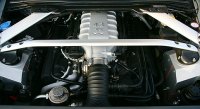 On
paper, the 4.3-litre V8 of the baby Aston is also considered to be
sub-standard. The origin of the engine is the 300 hp 4.2-litre Jaguar
V8. Although Aston tried very hard to improve it with its own cylinder
heads, intake manifolds, pistons, con-rods and crankshafts to loosen
its top end, it can only liberate another 80 horsepower at 7000 rpm.
The 302 lbft torque is as unimpressive. With variable valve timing at
the intake side only (this is untouched from the Jaguar engine), and
the lack of variable intake manifolds, no wonder it produces power
without the efficiency of Porsche's boxer engine, let alone Ferrari's
4.3-litre V8. The F430 engine produces an astonishing 110 more
horsepower from the same capacity and 40 lbft more torque. That car
stormed to 60 mph in 3.6 seconds and tops 196 mph. This makes the
Aston's 4.9 seconds and 175 mph almost leisure. Even the Carrera S' 4.4
sec and 182 mph can easily leave the Aston in dust. On
paper, the 4.3-litre V8 of the baby Aston is also considered to be
sub-standard. The origin of the engine is the 300 hp 4.2-litre Jaguar
V8. Although Aston tried very hard to improve it with its own cylinder
heads, intake manifolds, pistons, con-rods and crankshafts to loosen
its top end, it can only liberate another 80 horsepower at 7000 rpm.
The 302 lbft torque is as unimpressive. With variable valve timing at
the intake side only (this is untouched from the Jaguar engine), and
the lack of variable intake manifolds, no wonder it produces power
without the efficiency of Porsche's boxer engine, let alone Ferrari's
4.3-litre V8. The F430 engine produces an astonishing 110 more
horsepower from the same capacity and 40 lbft more torque. That car
stormed to 60 mph in 3.6 seconds and tops 196 mph. This makes the
Aston's 4.9 seconds and 175 mph almost leisure. Even the Carrera S' 4.4
sec and 182 mph can easily leave the Aston in dust.
So what did Ulrich Bez bring to Aston?
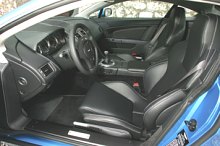 The
answer is desirability. We always know desirability is not necessarily
related to measurable performance. I prefer to use Smart Roadster as an
example: it runs like a turtle, but its desirability matches a 911. The
same can apply to the baby Aston. The
answer is desirability. We always know desirability is not necessarily
related to measurable performance. I prefer to use Smart Roadster as an
example: it runs like a turtle, but its desirability matches a 911. The
same can apply to the baby Aston.
The desirability starts when you drop in its hand-stitched leather
buckets. The V8 Vantage employs a metallic instrument panel and center
console almost exactly the same as DB9. The bespoke feel is not mass
production sports cars like Porsche can reproduce.
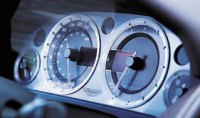 Then you press the start button
and the V8 comes alive. Squeeze the throttle and it roars loudly in a
raw and violent sound, like an angry lion. What a sound ! how it
cheated those noise regulations is a mystery, but this unique sound
definitely adds to the unique experience in the Aston. Then you press the start button
and the V8 comes alive. Squeeze the throttle and it roars loudly in a
raw and violent sound, like an angry lion. What a sound ! how it
cheated those noise regulations is a mystery, but this unique sound
definitely adds to the unique experience in the Aston.
I suspect the engine sound is one of the secret weapons of Bez to fight
against his ex-employer, because it comes at no extra cost and it lets
the V8 Vantage feel faster than it is. In fact, the car cannot keep up
with Carrera S, let alone GT3 and the similarly priced 911 Turbo. BMW
M6 is also faster. But these German cars have a common problem: they
are mass production, or based on a mass production model. People buy
them to exploit their performance. In contrast, the baby Aston is more
like Ferrari (its production rate is the same as F430) - people buy
them to enjoy their style and character, plus the premium image they
deliver.
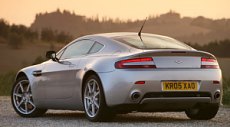 That said, the V8 Vantage is
the most user friendly Aston Martin to date. Its power delivery is
smooth and linear, its clutch is light and progressive, its gearshift
is even one of the best in the industry, being crisp and short. The
driveline refinement is impressive. That said, the V8 Vantage is
the most user friendly Aston Martin to date. Its power delivery is
smooth and linear, its clutch is light and progressive, its gearshift
is even one of the best in the industry, being crisp and short. The
driveline refinement is impressive.
On
the
other hand, the V8 Vantage also rides and handles brilliantly. Compare
with the stiffly sprung DB9, the baby Aston rides much more
comfortable, thanks to the lighter engine, stronger chassis and the
extra time it spent to refine the damping. The ride is firm but supple
enough to be a long distance cruiser. On poorly surfaced B roads, it is
even more absorbent than the 911 Carrera S.
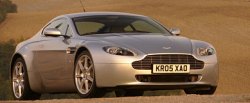 Steers
into corners, the baby Aston's flat body control and superb balance
inspires confidence. It might be just 140 kg lighter than the DB9, but
it feels much more nimble and the difference is the same as their type
suggest: sports car vs grand tourer. The steering, having lost speed
sensitive power assistance, is more precise and faithful than the DB9. Steers
into corners, the baby Aston's flat body control and superb balance
inspires confidence. It might be just 140 kg lighter than the DB9, but
it feels much more nimble and the difference is the same as their type
suggest: sports car vs grand tourer. The steering, having lost speed
sensitive power assistance, is more precise and faithful than the DB9.
That said, Porsche 911 Carrera S is even sharper – its steering has
more feedback at lock, its tires provide more traction, its brakes are
more powerful, and it corners with higher limit than the Aston can
manage. The margin is small, but in every objective area the German car
outperforms the British car even though it is considerably cheaper. It
proves that Porsche is still the standard of sports car industry.
However, the high level of precision, refinement and user friendliness
achieved by the baby Aston is already sufficient to impress its wealthy
target customers. Then they will consider the subjective aspects –
design, engine sound, exclusivity.... Bez knows this business very well. |
Verdict:     |
| Published
on 18
Feb 2008 |
All rights reserved.
|
|
V8 Vantage N400
|
|
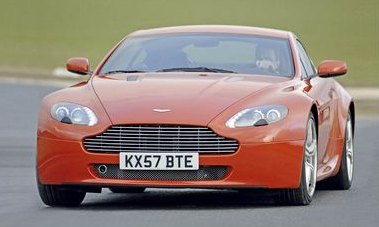 The best handling Aston ever made...
The best handling Aston ever made...
Have
you ever heard Aston
Martin
mentioned how fast its cars lapped Nurburgring Nordschleife ? Five
years ago no one could have imagined that, because the British luxury
sports car brand used to stress brutal power and impeccable
craftsmanship more than anything else. But time as changed since German
guy Ulrich Bez sitting at the top of the company. He copied the
know-how trained in Porsche to Gaydon and started measuring the
absolute performance of his cars according to Nurburgring lap time. In
this way, a sportier version of V8 Vantage was produced. It lapped
Nurburgring Nordschleife in less than 8 minutes, which matched a 911
Carrera S. Aston would call it N400, where N stands for Nurburgring and
400 is the horsepower count. Some 480 units of this car will be
produced before most of its technology is transferred to the production
V8 Vantage. Each one will cost 13 percent more than the standard car.
Externally, the V8 Vantage N400 doesn't differ much from the regular
car. What impress us most are the tuned engine and suspensions. The
4280 cc V8 gets a smoother intake system and revised engine management
program to liberate more power from the mid-range to the top end. Now
it generates 400 horsepower at 7300 rpm instead of 380 hp / 7000 rpm.
Maximum torque increases a little bit as well. Subjectively, the engine
feels livelier than the numbers suggested. However, Aston claims 0-60
mph is reduced by only 0.1 seconds while top speed is increased by 2
mph.
That means most of the reduction in lap time is down to the suspension
upgrade. Stiffer springs (40% up at front and 30% up at the rear),
stiffer dampers and thicker rear anti-roll bars improves the body
control a lot, resulting in flat cornering and excellent high-speed
stability. Amazingly, the ride quality is actually improved over the
regular V8 Vantage, thanks to the well-judged damping as well as the
lower unsprung mass contributed by lighter alloy wheels.
Unquestionably, N400 is the best handling Aston ever made. However, a
911 Carrera S is considerably cheaper, while GT3 is faster and sharper
still. The Aston will need more muscle to justify its price. |
Verdict:     |
| Published
on 5
Jun
2008 |
All rights reserved.
|
|
V8 Vantage 4.7
|
|
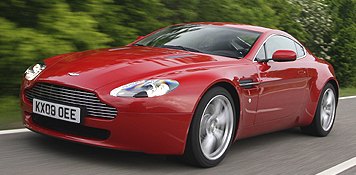 AM V8 no longer feels second-class to
911 Carrera S and Audi R8...
AM V8 no longer feels second-class to
911 Carrera S and Audi R8...
Soon
after the completion of V8
Vantage N400, Aston Martin introduced an evolutionary upgrade to the
whole V8 Vantage line. This is certainly not a “facelift”, because
apart from a different wheel design there is no changes at all to the
exterior – no complaints here, considering how good the V8 Vantage
always looks. There are some refinements made to the interior, but they
are too minor to be mentioned in AutoZine, too. The biggest change is
the V8 engine, which has grown from 4.3 to 4.7 liters.
By lengthening the stroke by 5mm and enlarging the bore by 2mm, Ford’s
Cologne engine plant (which builds all Aston Martin engines) increased
the capacity of the V8 to 4735 cc. Predictably, a larger bore requires
larger valves, intake ports and manifolds, while the longer stroke
requires a new forged crankshaft and conrods. Cologne also took this
chance to lighten the conrods and counter weights to improve engine
response. As a result, horsepower has been up by 40 to 420. Max torque
is 347 lb-ft, a considerable improvement from the previous 302 lb-ft.
Aston claims top speed is raised from 175 mph to 180 mph, while 0-60
mph acceleration is reduced from 4.9 to 4.7 seconds.
In normal driving, you can feel the extra punch from 3500 rpm upwards,
but the magnitude (and sound) is not as sensational as the
similarly-sized V8 of Maserati GranTurismo S or Alfa Romeo 8C
Competizione. Among 2-seater sports cars it is not particularly quick.
In fact, it is still slower than Porsche 911 Carrera S, which is quite
disappointing because it has a larger engine, a more sophisticated
aluminum chassis and a higher price tag. We heard Cologne will build a
5.0-liter version V8 for Jaguar. Why doesn’t Aston Martin employ an
engine at least as large ? You know, the name “V8 Vantage” used to
refer to a 5.3-liter V8 model, so there is still plenty of space for
upgrade.
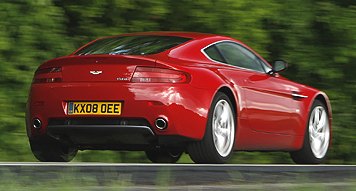 Why doesn't it employ a 5.0 V8 like
the future Jaguar ?
Why doesn't it employ a 5.0 V8 like
the future Jaguar ?
To save the day, at least the new engine is more economical and clean.
Fuel economy is improved from 18.8 mpg to 20.4 mpg, while CO2 emission
is reduced from 358g/km to 328g/km. Like many other cases, a larger and
torquer engine actually reduces fuel consumption as it does not need to
be revved so hard.
Apart from engine, Aston also refined the drivetrain by introducing a
lighter clutch and flywheel, refined software of Sportshift
semi-automatic to improve response in Sport mode and improve smoothness
in Comfort mode. That said, this gearbox is still far from world class,
thus the standard 6-speed manual is always recommended. At the chassis,
suspensions have received stiffer springs (up 11% front and 5% rear),
revised upper damper mountings and bump stops and standard low-friction
Bilstein dampers. Steering feel and accuracy is improved by revised
steering geometry and stiffer bushings at front lower suspension arms.
New 19-inch alloy wheels complete the chassis modifications.
On the road, there is a slight improvement to ride and handling.
However, to enjoy the full effect you must equip this car with the
optional Sports Pack, which includes 45% stiffer springs, retuned
dampers and lighter forged alloy wheels. For sure, low speed ride is
quite hard, but once you push the car its damping improves, its body
control is excellent, its rear end feels more planted and its steering
is meaty and responsive. On back roads the AM V8 no longer feels
second-class to 911 Carrera S and Audi R8. It still lacks the tactile
steering feel of Porsche and the controls are physical compare with
Audi, but it is engaging to drive nonetheless. Putting style and
exclusivity into the equation, the revised V8 Vantage is still a
sensible choice, if not the best of the class objectively.
|
Verdict:     |
| Published
on 19
Jun 2009 |
All rights reserved.
|
|
V12 Vantage
|
|
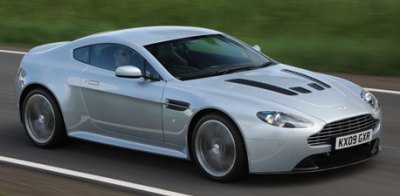 Combines the best of the both worlds:
V8 Vantage's chassis and DBS' V12...
Combines the best of the both worlds:
V8 Vantage's chassis and DBS' V12...
We
prefer the handling of
V8
Vantage to the bigger DBS as it is nimbler and better balanced.
However, its V8 engine, even in the latest 4.7-liter form, is no where
as powerful and aurally desirable as the 5.9-liter V12 sitting under
the bonnet of DBS. Now Aston Martin is going to give you the best of
both worlds in V12 Vantage. The concept behind this car is simple: drop
a big V12 into the compact chassis of Vantage, then beef up its
suspensions, brakes, tires etc. to create a hardcore driving machine. A
£135,000 price tag is closer to the level of DBS (£160,000)
than the standard V8 Vantage (£83,000), but its exclusivity is
guaranteed by limiting annual production to 300-500 units. In other
words, it will be rarer than the small Ferraris, Lamborghini and
Porsche GT3 / GT2.
V12 Vantage measures the same length, width and wheelbase as its V8
brother. Externally, it can be easily recognized by four cooling scoops
opened on the bonnet. The rest is similar to N400, including the
aggressive side skirts and tail spoiler. If you have eagle eyes, you
may notice its wider and lower profile Pirelli P-Zero Corsa tires.
Inside, everything is identical to the standard car except a few minor
alternations, such as carbon-fiber door handles, aluminum gearstick
and, if you pay an extra £1800, a pair of lightweight
carbon-fiber bucket seats by Recaro. The latter saves some 17 kilograms.
The 5935cc V12 has the same specifications as DBS, which means 510
horsepower and 420 lb-ft of torque. The only difference is that it is
mounted closer to the ground, so close that the depth of its sump has
to be cut by 15 mm and the smooth undertray of DBS has to go away. The
latter explains why its top speed is “only” 190 mph, or 1 mph lower
than DBS. Transmission is again that 6-speed manual transaxle – what
else can you expect for the most hardcore Aston Martin?
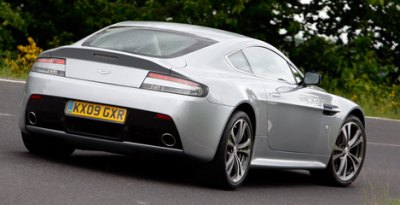 N400 donated its aggressive side
skirts and tail spoiler.
N400 donated its aggressive side
skirts and tail spoiler.
Because the V12 is heavier than the V8 by 87 kg, some weight has to be
trimmed elsewhere. Apart from the aforementioned Recaro seats, this car
employs Brembo carbon-cermaic brake as standard (same size and
specifications as DBS again), lightweight forged alloy wheels and
thinner inner rear quarter panels. In the end, V12 Vantage carries only
50 kg more than V8 Vantage. As a result, power-to-weight ratio has been
lifted from 258 to 304 hp per ton. On the downside, as the engine bay
does not have enough room to accommodate the whole V12 behind front
axle, its static weight distribution is reversed from 49:51 to 51:49.
Modifications to the chassis is business as usual. Its ride height has
been dropped by 15 mm to lower center of gravity. Front springs have
been stiffened by 70% to take on the extra weight of engine, versus 45%
at the rear. Front and rear anti-roll bars have gained 45% and 75%
stiffness respectively. Designed as a hardcore machine, the car forgoes
DBS’ electronic adaptive dampers.
On the road, V12 Vantage feels stronger, sharper and angrier than any
other current Aston Martins. Its big engine produces tremendous torque
so that the first two gears are superfluous. 3rd and 4th are what you
need to attack most roads. 0-60 mph can be easily done in 4.1 seconds,
very fast considering it doesn’t have Ferrari’s clever gearbox and
launch control. The engine is very responsive to your right foot. Press
the Sport button, its throttle response gets sharper still, so sharp
that you could feel a little nervous. The thunder coming from the V12
is another warning signal.
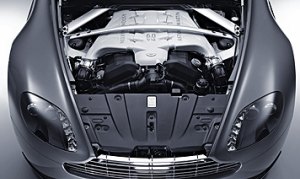 510hp V12 barely fits the small engine
compartment...
510hp V12 barely fits the small engine
compartment...
Surprisingly, despite of the extra weight over the front axle, the V12
Vantage doesn’t feel nose heavy. For sure it is not as flickable as 911
GT3, but it still steers accurately into bends as its front tires grip
hard and its body hardly rolls. Those semi-slick Pirelli Corsas
generate tremendous grip on dry surface – just beware of wet. What
really feel heavy are its controls, i.e. steering and gearshift. It
needs its pilot to work hard to deliver the best results, very much
like older generations of supercars. Should you do that, it will reward
you with accuracy and keen response. The ride quality is similar, hard
at low speed – but with just enough compliance to deal with pot holes –
and composed at high speed. Body control is always excellent, ditto the
powerful braking.
Ultimately, the car is not as agile as those lighter mid or
rear-engined rivals. You can storm a GT3 or Scuderia into bends more
fluently than the 1680 kg Aston, which needs a slow-in / fast-out
technique to avoid unsettling its balance. You may also ask for more
feel from its heavy helm. Otherwise, there are not many faults.
In terms of usability, V12 Vantage is at the extreme of the GT
spectrum. If you want to go long distance travel, it will give you just
enough bump absorption, luggage space or creature comfort to do so.
However, its true character is clearly in the sporting side. This is
the GT2 of Aston Martin. One that combines maneuverability of modern
sports cars and some brutal character of traditional supercars.
|
Verdict:     |
| Published on 19
Mar 2011 |
All rights reserved.
|
|
V8 Vantage S
|
|
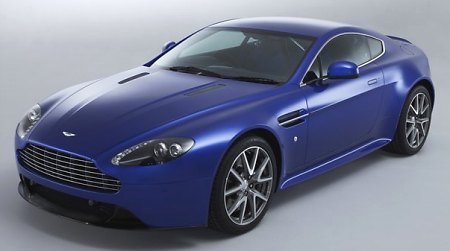
If you expect a big leap in performance, you might be
disappointed with Aston Martin V8 Vantage S. This car follows the mild
evolution strategy of Porsche, something no stranger to Aston boss Dr.
Bez. In his words, the existing V8 Vantage is so right that no big
changes but fine polishing are necessary. Its VH aluminum platform is
still state of the art. Its V8 still produces the loveliest noise
around. Its exterior is still beautiful and its interior is as
tasteful as before. I mostly agree his arguments, but I believe the
mildness of its evolution is more due to the company's lack of funding
since its independence from Ford three years ago.
As a result, the S version – even the S stands for Sport – is not as
powerful as you would expect. The 4.7-liter V8 gets only a boost of 10
horsepower and 14 pound-foot of torque through revised intake and
ignition and new mufflers. It is not as punchy as Maserati MC
Stradale's same-capacity V8, especially at mid-range rev. Due to the
lack of variable intake manifolds and variable exhaust cam phasing, its
power concentrates at the upper end, so you will need to work harder
through gearchange to keep the engine boiling within its sweet zone,
which lies somewhere between 5000 and 7300 rpm. Fortunately, the new
Graziano 7-speed Sportshift II gearbox helps. With an additional ratio,
its first 6 ratios can be stacked closer to aid the engine, so you get
the desired rev more easily.
Nevertheless, the robotized manual gearbox is by no means the best
gearbox around. Aston chose it instead of modern twin-clutch box
because it fits into the Vantage without much modifications. Yes, it is
much lighter than DCTs – even compare to the old 6-speed Sportshift it
is 24 kg lighter, thanks largely to switching from oil to air cooling –
but the shift quality is far from perfect, much less smooth than DCTs.
It has two modes – normal or sport. In the former, gearshift is
sluggish. In Sport mode, gearshift is said to be 20 percent faster than
before, but even so it is nowhere as responsive as the one of Maserati
MC Stradale, which is also a single-clutch box. That said, the Aston
gearbox works well at 100 percent
effort. Push the engine harder and you will get better response from
the gearbox. Gearchange near redline is fast and incisive, if slightly
brutal. The new gearbox might be temperamental, but the reward it
brings to hardwork is quite satisfying.
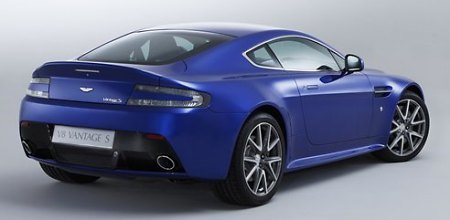
The Sport button not only speeds
up
gearshifts but also throttle
response and switch the new mufflers to "loud" mode. I always think the
V8 Vantage produces the angriest noise among road cars, more so than
any Ferrari flat-crank V8s. The S version is even crazier once its
bypass valves open. It is a race-car-like scream – sharp, raucous and
incredibly loud. How it can pass noise regulations is a mystery. If
there is any area the car clearly overwhelms its rivals, it is
definitely the noise.
Rest of modifications are predictable. The
S gets lower and firmer suspension setup (still without adaptive
damping
though), larger front brake discs (380mm instead of 355mm) with
6-piston calipers, wider Bridgestone rubbers, lightweight wheels and a
quicker
steering rack (15:1 instead of 17:1). The whole car is 30 kg lighter
than the standard Vantage. All these sum
up to a better chassis dynamics. The ride is definitely firm on rough
surfaces,
but in return it brings more composure at speed, and the chassis feels
tauter
and sharper all the time. The combination of quicker steering and
enhanced
front-end grip sharpens its turn-in, if not really sorted out its
slight nervousness at the limit of adhesion. Overall, the S is more
capable and
more
entertaining than the standard V8 Vantage while losing no
friendliness as a road car.
However, I can't help thinking more could have been done if Aston was
given a bigger R&D budget. The engine could be more advanced, more
powerful and flexible. The ride could be more supple if adaptive
dampers are introduced. The gearbox could be quicker and slicker. These
weak spots prevent the V8 Vantage S from challenging the laurels of
Porsche 911 Turbo, Audi R8 and Nissan GT-R. That said, those buying the
Aston are unlikely to make purchasing decisions purely on the ground of
objective measurement. If exclusivity, style and engine noise are
especially important to you, then it will be a very good choice. |
Verdict:     |
| Published
on 19
Mar
2013 |
All rights reserved.
|
|
V12 Zagato
|
|
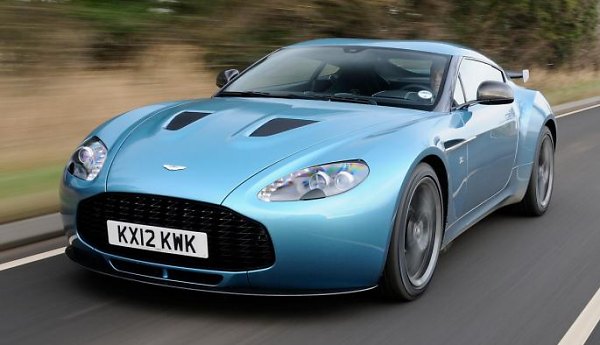
|
The partnership between
Aston Martin and Italian coachbuilder Zagato is one of the most
romantic in the car industry. 52 years ago, they joined forces to
create DB4GT Zagato, one of the most
sought after classic cars of all time. In the 1980s, they built the
fastest car in the world, Zagato.
At the turn of the millenium, they produced two more cars based on the
DB7, i.e. DB7 Zagato and DB AR1. However, today Zagato no
longer stands at the forefront of design and coachbuilding business. To
Aston, its own designer Marek Reichman can draw prettier (and less
strange) designs, while the craftsmen at Gaydon are capable to deliver
higher build quality than Zagato's outdated technique. As a result, the
creation of V12 Zagato actually has no involvement of Zagato. The
latter becomes merely a nameplate licensed to keep the legendary story
goes on.
The V12 Zagato is built on V12 Vantage, the most sporting Aston Martin
to date. It combines the same 510 horsepower V12 and short-wheelbase
chassis to give maximum performance and handling. The bodywork is
pretty stylish. Although there is a strong resemblance to Nissan GT-R
in its blackened A-pillars and sloping side windows, the double-bubble
roof is a pure Zagato signature. The same goes for the big mouth up
front. On the other hand, the racing rear spoiler, pseudo diffuser and
cat-eye taillights inject a sense of aggression to differ it from the
donor car.
Part of the body work is made of carbon-fiber, such as the front and
rear fenders, door sills and boot lid, whereas the remaining (bonnet,
doors and roof in particular) are hand crafted aluminum. The whole car
takes 2,000 man-hours to build, 10 times that of the regular car and
just 500 less than the One-77. This explains why it commands
£330,000 (plus local taxes), and production is limited to 101
units. Its production is carried out by the same guys who have just
finished the production run of One-77.
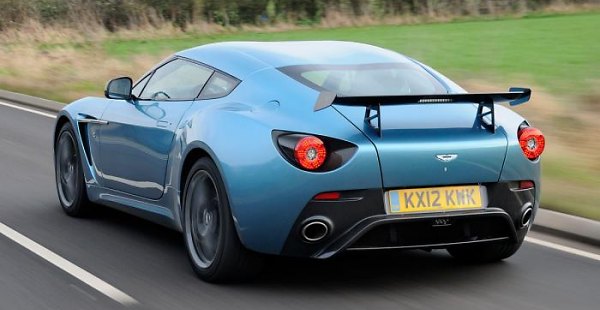
|
£330,000 plus taxes is way more expensive than a Ferrari F12 or
Lamborghini Aventador (both at £240,000 including tax), but the
performance it offers remains at the level of V12 Vantage – 190 mph top
speed and 0-60 mph in 4.1 seconds. The handling and ride it offers are
also remarkably close to the regular car that costs just a third of its
price. Aston did not spend much time to modify its suspensions or
steering. Neither did it stripe out its interior to save weight. This
mean the Zagato carries the same 1680 kg kerb weight. Admittedly, the
V12 Vantage has always been a keen driver's car. It might not be as
quick or as sharp as Ferrari or Porsche, but its steering is
communicative, its responses are honest and it engages its driver in
the same way as the best classic sports cars. The rebodied version is
the same. Buyers will never complain for lack of driving thrills.
Still, the absurd price tag can hardly be justified by the new body
shell and mildly retrimmed interior, or the exclusivity brought by its
rarity. Yes, not many cars are so rare, but Aston can easily create
similar specials in the future – and I have no doubt that another one
will follow it closely once all 101 cars are sold. After all, it is the
product instead of production numbers that counts. In my opinion, it is
more reasonable for One-77 to charge £1.2 million because it is a
thoroughly new development. Even though the V12 Zagato is almost as
rare and cost "just" a third, it is not quite desirable and
collectible.
|
Verdict:    |
| Published
on 10
Oct
2013 |
All rights reserved.
|
|
V12 Vantage S
|
|
Following Vanquish and DB9,
the V12 Vantage is also upgraded to the 4th generation VH platform and
variable-valve-timing V12. Unsurprisingly, the new car is called V12
Vantage S.
At a glance, the new car looks almost indistinguishable from the old
car. Its main difference is the front grille, now made of black
carbon-fiber frames instead of aluminum ones. Another noticeable
difference is the set of 10-spoke forged alloy wheels, now cuts 1 kg of
unsprung weight at each corner. Otherwise, the car looks practically
the same as the old one. As before, the V12 model uses a bonnet with
four ventilation outlets to cool the larger engine. This distinguishes
it from lesser V8 Vantage.
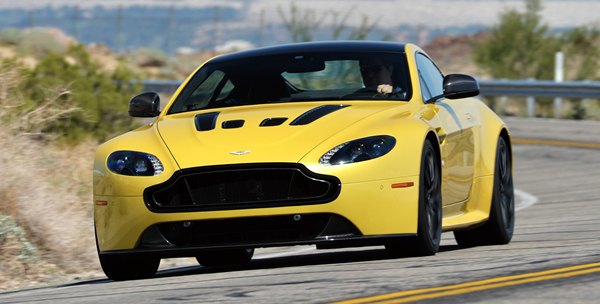 |
Big news is the AM28 V12 engine. It is identical to the AM11 used on
Vanquish except minor differences in mapping. With CNC-machined
combustion chambers, lightweight hollow camshafts and dual-VVT, it
produces exactly the same output as its bigger brother, i.e. 573 hp (or
565 bhp) and 457 lbft of torque, up 11% and 9% respectively from the
old engine. The peak power is now released 250 rpm higher at 6750 rpm,
so it is freer and stronger at the top end.
Another good news is the use of Graziano 7-speed automated manual
transaxle. Aston calls it Sportshift III, as it is an upgrade from the
Sportshift II unit launched on V8 Vantage S a couple of years ago. Its
extra top gear enables the top speed to be stretched to 205 mph, a
significant increase from the previous 190 mph, while keeping the other
6 ratios close to aid acceleration. The official 0-60 mph time is
quoted at 3.7 seconds, a sizeable improvement from the previous 4.1
sec. Incredibly, the new 7-speed transaxle is 25 kilograms lighter than
the old 6-speed unit. As a result, the whole car is also a tad lighter.

|
The 4th gen VH platform has quite a lot of advances. First is the
improved insulation, which cuts cabin noise by 30 percent. Second is
the adoption of 3-stage adaptive dampers, which should make the ride
and handling more versatile than ever. It provides Normal, Sport and
Track modes to choose from. The Sport and Track damper settings also
alter the weighting of the hydraulic power steering. Meanwhile, another
Sport button on the console can alter throttle response, gearshift
speed and exhaust noise. Speaking of exhaust, the lightweight muffler
comes directly from the Vanquish and One-77, guaranteeing great sound.
Like the V8 Vantage S, it adopts a quicker steering rack with ratio
reduced from 17:1 to 15:1. As before, the V12 model employs Brembo
carbon-ceramic brakes, although it is now upgraded to the 3rd
generation or CCM3. The sticky Pirelli P-Zero Corsa tires are carried
over.
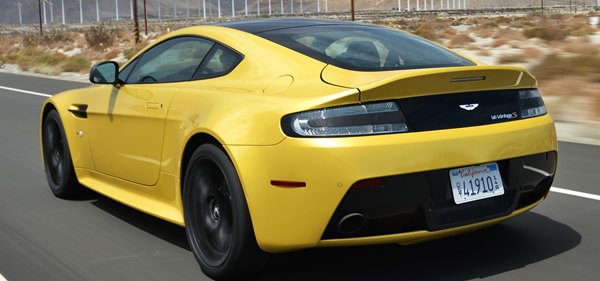
|
On the road
It is a little disappointing to see that the cabin looks the same as
the old car, which starts getting dated. It seems that Aston does not
have the resources to redo the car from ground up, so the new wine has
to settle with an old bottle.
However, if you focus on the driving experience, the V12 Vantage gets
better than ever. In the past, it was already an excellent sports car,
with sharp responses, engaging and predictable handling as well as
addictive engine sound to match the best Italian supercars, but
unfortunately it lacked the right performance. Thanks to the upgrade,
the gap is largely narrowed. It is still slower than Ferrari 458 or
McLaren MP4-12C, but no longer embarrassingly so. There is noticeably
more low-end grunt to aid acceleration. On full song, the V12 engine
note has to be rated as one of the best in the world, one that easily
beats the flat-crank V8 noises of Ferrari and McLaren.
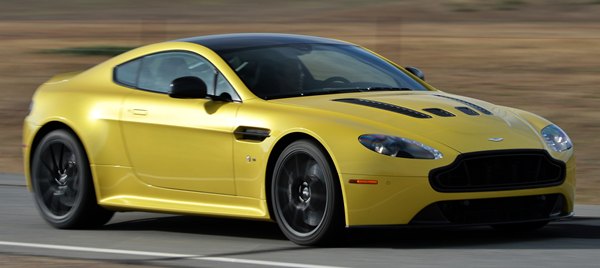
|
The 7-speed automated manual is undoubtedly better than the older
Sportshift II in other Astons, but it still takes some getting used to.
Its downshift is near perfect, but upshift is considerably slower and
clunkier than modern twin-clutch gearboxes. This hurts the driving
satisfaction a bit. Nevertheless, you can learn to live with it. By
lifting off throttle appropriately during upshift, the delay can be
reduced to acceptable level. Still, you may miss the joy of using the
good old manual gearbox.
The chassis remains first class. The V12 Vantage S remains the best
driving car among all Aston Martin models. Its handling is faithful.
Its steering is sharp and feelsome. Its brakes are powerful yet return
good pedal feel. The combination of a big front-mounted engine,
rear-wheel drive and short wheelbase does not hurt its handling. On the
contrary, its behaviour is very predictable. You can overcome its
slight understeer with steering and throttle beautifully in bends.
Without resorting to electronic aids, its chassis displays exceptional
balance. It is one of the few supercars that feels truly confidence
inspiring to drive at the limit and to push on narrow mountain roads.
The new car's quicker steering and adaptive damping just improves it a
little further, all the while without altering its adorable essence. It
might lack the thrills and sense of occasion of Ferrari 458, but it is
more engaging to drive than the new 911 Turbo S which costs the same
money. British sports cars are not dead yet.
|
Verdict:     |
| Published
on 14
Aug
2015 |
All rights reserved.
|
|
Vantage GT12
|
|
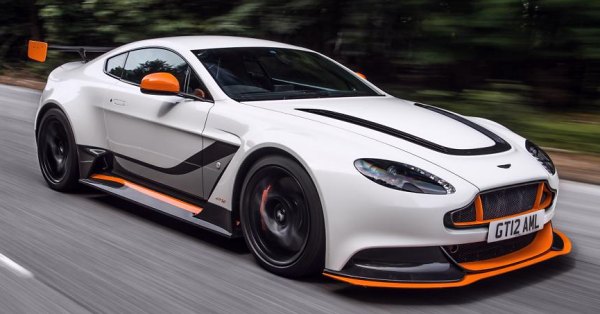
|
Recently I observed a trend
in the sports car industry: building a small batch of very expensive
sports cars is easier to earn money than large quantity of production
sports cars like 911. That’s why many makers turn to introduce
super-pricey exclusive models. One of them is Aston Martin. Following
the One-77 and V12 Zagato, it is working on 2 new exclusive models,
Vantage GT12 and Vulcan. Both are track-oriented, just like Ferrari 458
Speciale or McLaren 675LT, and both are very expensive, costing
£250,000 and £1.5 million respectively. The Vantage GT12
materialized first, because it is based on the GT3 race car which
enjoys quite a lot of success on racing circuits.
This car would have been called Vantage GT3 if not Porsche objected to
the idea. Never mind, as GT12 is a good reminder of how many cylinders
it possesses. Yes, this is a
classic Aston Martin with a big V12 up front driving the rear wheels.
Its single-clutch 7-speed automated manual box sits at the rear axle to
improve balance, but it doesn't have state-of-the-art mechatronics like
active differential, torque vectoring or side slip control. The basic
elements are actually carried over from the production V12
Vantage S, but the GT12 can command double the price thanks to some
extensive modifications, ranging from weight reduction, power upgrade
to aerodynamics improvement. Oh yes, also because its production is
limited to 100 units.
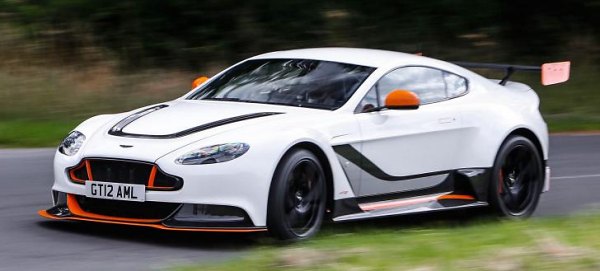
|
The GT12 looks really like a race car. It has a massive rear spoiler,
and its aggressive front splitter, skirts and diffusers leave little
ground clearance. Its flared fenders house wider Michelin Pilot Super
Sport tires, too. These aero kits as well as the bonnet, front fenders,
doors and roof are made of carbon-fiber to save weight, while the rear
screen and side quarter windows are polycarbonate items. The new
single-locking wheels are made of lightweight magnesium, ditto the
torque tube that connects between the V12 and transaxle. The new
exhaust is made of titanium. Inside, Aston leaves the air-con and
infotainment system intact, but the door panels, center
console/transmission tunnel as well as bucket seats are all converted
to carbon-fiber. The cabin is trimmed with lightweight Alcantara
instead of leather. The center console has switched to touch-sensitive
panel like Vanquish to save weight, too. In addition to a lithium
battery, the GT12 is 100 kg lighter than the standard V12 Vantage S,
tipping the scale at 1565 kg. Not quite as light as GT3 RS or 675LT,
but it’s the lightest V12 machine on the market.
That 5.9-liter motor now produces a full 600 horsepower at 7000 rpm, up
27 ponies from the standard model. This must thanks to the lighter and
higher flowing magnesium intake manifolds as well as the titanium
exhaust. Peak torque barely inches up from 457 to 461 lbft, but the
Aston V12 has never been short of mid-range torque. Coupling to the
weight reduction, performance is awesome. It certainly feels very fast
and powerful, although the numbers don’t do it justice – its top speed
is dragged down to 185 mph by the massive spoilers and a shorter final
drive ratio, while standing
start acceleration (0-60 mph in 3.5 seconds) is limited by the traction
available at rear tires. In the real world, it feels faster. Part of
the reason is the shocking howl of the V12. It is not only much louder
than any road-going Astons but its aural thrills compare well with the
best Ferrari V12s. In fact, the noise has to be the most outstanding
element of this car.
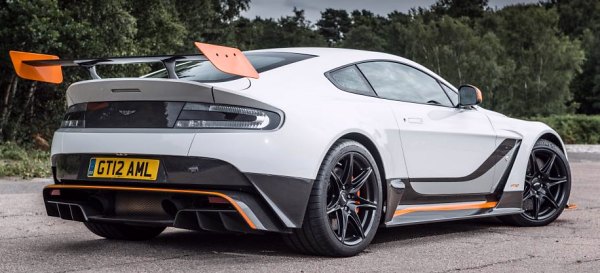
|
That is not to say the rest of the car unremarkable. It’s just not as
remarkable as the best bunch of track-biased sports cars, i.e. 458
Speciale, 675LT or 911 GT3 RS. The Aston does not produce as much
traction and grip as those cars thus it is more tail-happy, more prone
to oversteer should you turn off DSC and abuse its throttle. Despite of
the massive aero kits, it doesn’t produce as much downforce, too, at
least at road speeds. This means it feels wider and less precise to be
driven hard on country roads. However, the sharp throttle response of
the naturally aspirated V12 and the responsive, beautifully weighted
hydraulic-assisted steering deliver honest feedback that many rivals
couldn't quite match. It takes a while to understand its temper and
build trust on it, but the more miles you have driven the more it grows
on you. Eventually you will find an immensely fun and characterful
machine to work with.
Despite of the stiffer suspension setup, the GT12 still delivers enough
compliance on country roads provided you leave its adaptive damping in
Normal mode. If not the explosive engine noise and excessive tire roar,
it would have been easily suitable for everyday use. The only real
weakness is the Sportshift III automated gearbox, whose shifts are
jerky and slow compared with a dual-clutch box. It deserves a better
gearbox.
|
Verdict:     |
Published
on 19
Jun 2016
|
All rights reserved.
|
|
Vantage GT8
|
|
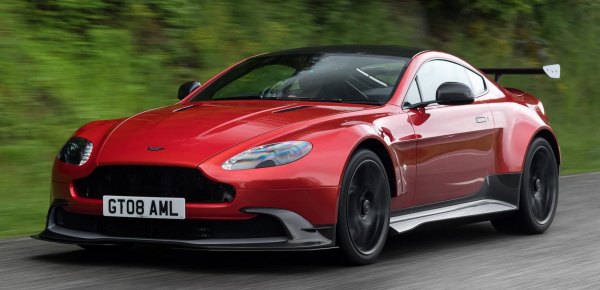
|
It is easy to downplay
Aston Martin Vantage GT8 by looking at its figures only. For a car
costing £165,000 before options, you should expect McLaren 570S
or even Ferrari 488 level of performance, but the GT8 offers only 446
horsepower from its 4.7-liter V8, or a mere 10-hp boost from the usual
Vantage
S which costs £95,000. Its 190 mph top speed and 4.2 seconds 0-60
mph are also not what you would call "supercar league”. It is not even
as quick as a Porsche 911 Carrera S. Those race-car big spoilers and
skirts just make its modest performance all the more ridiculous!
Frankly, limited edition Aston Martins have never been cheap. Like last
year’s GT12, you pay higher prices for the GT8 for its rarity, its
bespoke design and components. As only 150 units will be built, this
investment won’t be wrong. Moreover, you are buying not just another
Aston Martin special but probably the very last old-school Aston Martin
sports car, one comprises of a naturally aspirated V8, a manual
transaxle gearbox, passive dampers and a good old hydraulic steering.
By the way, the successor of Vantage is set to receive Mercedes 4.0 V8
turbo and electric power steering. This is already a good reason to pay
the premium for the farewell edition.
Aston said the GT8 is the road-going version of its Vantage GTE race
car, but I guess it would be more appropriate to call it the V8 version
of GT12. Many of its carbon-fiber supplements come
from that car, such as the massive rear spoiler, front splitter, side
skirts, diffusers, roof and inner door panels. Ditto its lithium
battery and polycarbonate windows (rear screen and rear quarter). It
also features similar (but not exactly the same) carbon-fiber fenders,
titanium exhaust and lightweight magnesium center-lock wheels. With all
lightweight options it is 100 kg lighter than the standard car, or a
kerb weight of 1510 kg. Nevertheless, that is still 90 kilos more than
a 911 GT3 RS. On the plus side, the Aston keeps air-conditioning, audio
system and sat-nav, so it is not as one-dimensional as its racy looks
suggested.
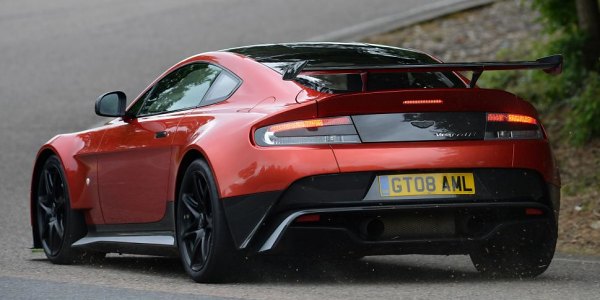
|
The car’s flared fenders house wider tracks, but surprisingly, the
wheels and tires remain the same size as the regular Vantage S,
although it turns to semi-slick Michelin Pilot Sport Cup 2 rubbers for
more grip. The suspension’s springs, dampers and anti-roll bars get
stiffer. As in the case of the regular car, it rides firmly in town,
but out of town with 40 mph or more, ride quality improves markedly.
You would
realize that its suspension is still designed primarily for road use.
The higher the speed, the better it soaks up bumps and floats over the
road.
Such an enthusiasm for action is also evident in other controls. The
hydraulic-assisted steering is heavy at low speed but lights up at
speed. Regardless of speed, it is always loaded with tactile feedback,
nudging in your hands and telling you about the surface ahead. What a
pity its days are numbered.
While the car doesn’t feel light, its chassis balance is first rate,
thanks to the Vantage’s optimum positioning of engine (close to fire
wall) and gearbox (at the rear axle). As its grip limit is not overly
high, you can put the car to dance in fast corners. Prod the throttle
momentarily and you can push the tail out with millimeter accuracy.
Flick the steering and the front wheels also break away, resulting in a
rally-car-style 4-wheel drift! Only a chassis with great balance and
feedback can do so.
The 4.7-liter V8 is an outdated design. It is neither very powerful nor
torquey by today's standards, but it is adequate for road use. It
has a linear power delivery and a willingness to spin to 7500 rpm. The
fact
that you can usually access its top end on road is a bonus, because
from 5000 rpm upward its thunderous noise produced by the large-bore
titanium exhaust is just amazing! It’s racecar-loud yet comes with an
addictive sound quality. Next to the chassis balance, this is the main
attraction of the car.
So perhaps we should not pay too much attention to numbers. Sometimes
quality is more important than quantity… provided you can afford it, of
course.
|
Verdict:     |
|
|
|
|
|
|
|
|
|
|
V8
Vantage 4.3
|
2005
|
| Front-engined,
RWD |
Aluminum spaceframe
|
Aluminum, steel, composites
|
| 4382 / 1866 / 1255 mm |
| 2600 mm |
V8, 90-degree
|
| 4280 cc |
DOHC 32 valves, VVT
|
| - |
| - |
| 380 hp |
| 302 lbft |
6-speed manual
|
All double-wishbones
|
| - |
F: 235/40ZR19
R: 275/35ZR19 |
1570 kg
|
| 175 mph (c) |
4.9 (c) / 4.9* / 4.7**
|
| 11.5* / 11.4** |
|
V8
Vantage N400
|
2008
|
| Front-engined,
RWD |
Aluminum spaceframe
|
Aluminum, steel, composites
|
| 4380 / 1865 / 1255 mm |
| 2600 mm |
V8, 90-degree
|
| 4280 cc |
DOHC 32 valves, VVT
|
| - |
| - |
400 hp / 7300 rpm
|
310 lbft / 5000 rpm
|
6-speed manual
|
All double-wishbones
|
| - |
F: 235/40ZR19
R: 275/35ZR19 |
1630 kg
|
| 177 mph (c) |
4.8 (c)
|
| - |
|
V8
Vantage 4.7
|
2008
|
| Front-engined,
RWD |
Aluminum spaceframe
|
Aluminum, steel, composites
|
| 4380 / 1865 / 1255 mm |
| 2600 mm |
V8, 90-degree
|
| 4735 cc |
DOHC 32 valves, VVT
|
| - |
| - |
420 hp / 7000 rpm
|
347 lbft / 5750 rpm
|
6-speed manual or
6-speed automated manual
|
All double-wishbones
|
| - |
F: 235/40ZR19
R: 275/35ZR19 |
1630 kg
|
| 180 mph (c) |
4.7 (c) / 4.3*** (auto-manual)
|
10.2*** (auto-manual)
|
|
|
|
|
|
Performance
tested by: -
|
|
|
|
|
|
|
V12
Vantage
|
2009
|
| Front-engined,
RWD |
Aluminum spaceframe
|
Aluminum, steel, composites
|
| 4380 / 1865 / 1241 mm |
| 2600 mm |
V12, 60-degree
|
| 5935 cc |
DOHC 48 valves
|
| VIM |
| - |
517 hp / 6500 rpm
|
420 lbft / 5750 rpm
|
6-speed manual
|
All double-wishbones
|
| - |
F: 255/35ZR19
R: 295/30ZR19 |
1680 kg
|
| 190 mph (c) |
4.1 (c) / 4.3* / 4.2**
|
9.3* / 9.2**
|
|
V8 Vantage S
|
2011
|
| Front-engined,
RWD |
Aluminum spaceframe
|
Aluminum, steel, composites
|
| 4380 / 1865 / 1255 mm |
| 2600 mm |
V8, 90-degree
|
| 4735 cc |
DOHC 32 valves, VVT
|
| - |
| - |
430 hp / 7300 rpm
|
361 lbft / 5000 rpm
|
7-speed automated manual
|
All double-wishbones
|
| - |
F: 245/40ZR19
R: 285/35ZR19 |
1610 kg
|
| 190 mph (c) |
4.6 (c)
|
-
|
|
V12
Zagato
|
2013
|
| Front-engined,
RWD |
Aluminum spaceframe
|
Aluminum, carbon-fiber
|
| 4385 / 1865 / 1250 mm |
| 2600 mm |
V12, 60-degree
|
| 5935 cc |
DOHC 48 valves
|
| VIM |
| - |
517 hp / 6500 rpm
|
420 lbft / 5750 rpm
|
6-speed manual
|
All double-wishbones
|
| - |
F: 255/35ZR19
R: 295/30ZR19 |
1680 kg
|
| 190 mph (c) |
4.1 (c)
|
-
|
|
|
|
|
|
| Performance
tested by: - |
|
|
|
|
|
|
V12
Vantage S
|
2013
|
| Front-engined,
RWD |
Aluminum spaceframe
|
Aluminum, steel, composites
|
| 4385 / 1865 / 1250 mm |
| 2600 mm |
V12, 60-degree
|
| 5935 cc |
DOHC 48 valves, DVVT
|
| VIM |
| - |
573 hp / 6750 rpm
|
457 lbft / 5750 rpm
|
7-speed automated manual
|
All double-wishbones
|
Adapive damping
|
F: 255/35ZR19
R: 295/30ZR19 |
1665 kg
|
| 205 mph (c) |
3.7 (c) / 3.9*
|
8.6*
|
|
Vantage
GT12
|
2015
|
| Front-engined,
RWD |
Aluminum spaceframe
|
Mainly carbon-fiber
|
- / 1905 / 1250 mm
|
| 2600 mm |
V12, 60-degree
|
| 5935 cc |
DOHC 48 valves, DVVT
|
| VIM |
| - |
600 hp / 7000 rpm
|
461 lbft / 5500 rpm
|
7-speed automated manual
|
All double-wishbones
|
Adapive damping
|
F: 265/35ZR19
R: 325/30ZR19 |
1565 kg
|
| 185 mph (c) |
3.5 (c)
|
-
|
|
Vantage GT8
|
2016
|
| Front-engined,
RWD |
Aluminum spaceframe
|
Aluminum, carbon-fiber
|
| 4539 / 1923 / 1257 mm |
| 2600 mm |
V8, 90-degree
|
| 4735 cc |
DOHC 32 valves, VVT
|
| - |
| - |
446 hp / 7300 rpm
|
361 lbft / 5000 rpm
|
6-speed manual
|
All double-wishbones
|
| - |
F: 245/40ZR19
R: 285/35ZR19 |
1510 kg
|
| 190 mph (c) |
4.2 (c)
|
-
|
|
|
|
|
|
| Performance
tested by: *R&T |
|
|
|
|
|
|
|
|
Copyright©
1997-2016
by Mark Wan @ AutoZine
|
|